Analysis of an S8 Medication Error: A Nursing Case Study Examination
VerifiedAdded on 2020/03/02
|8
|2013
|428
Case Study
AI Summary
This case study examines an incident of incorrect S8 medication administration involving a newly graduated nurse. The analysis identifies the failure to perform the three drug checks, lack of autonomous execution of duties, and insufficient pharmaceutical knowledge as key contributing factors. The nurse administered the wrong medication to a patient, leading to a critical error. The assignment explores what the nurse could have done differently, emphasizing the importance of adhering to drug administration procedures, labeling medications, and using patient identifiers. The nurse discusses how she would implement the three-drug check, confirm medications before administration, and follow NMBA codes of professional conduct to prevent similar errors. The case study highlights the need for nurses to enhance their pharmaceutical knowledge and execute their duties independently to avoid medication errors and ensure patient safety.
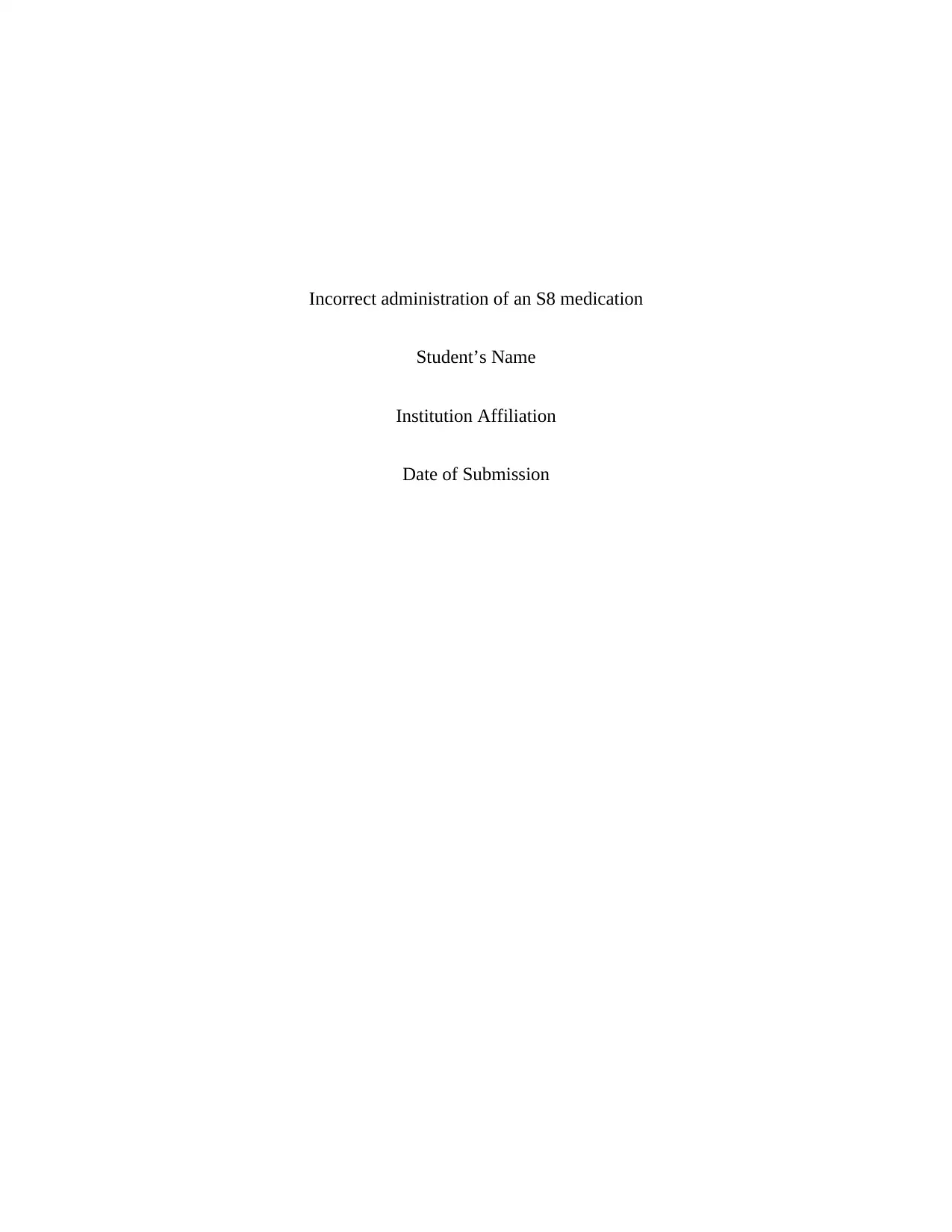
Incorrect administration of an S8 medication
Student’s Name
Institution Affiliation
Date of Submission
Student’s Name
Institution Affiliation
Date of Submission
Paraphrase This Document
Need a fresh take? Get an instant paraphrase of this document with our AI Paraphraser
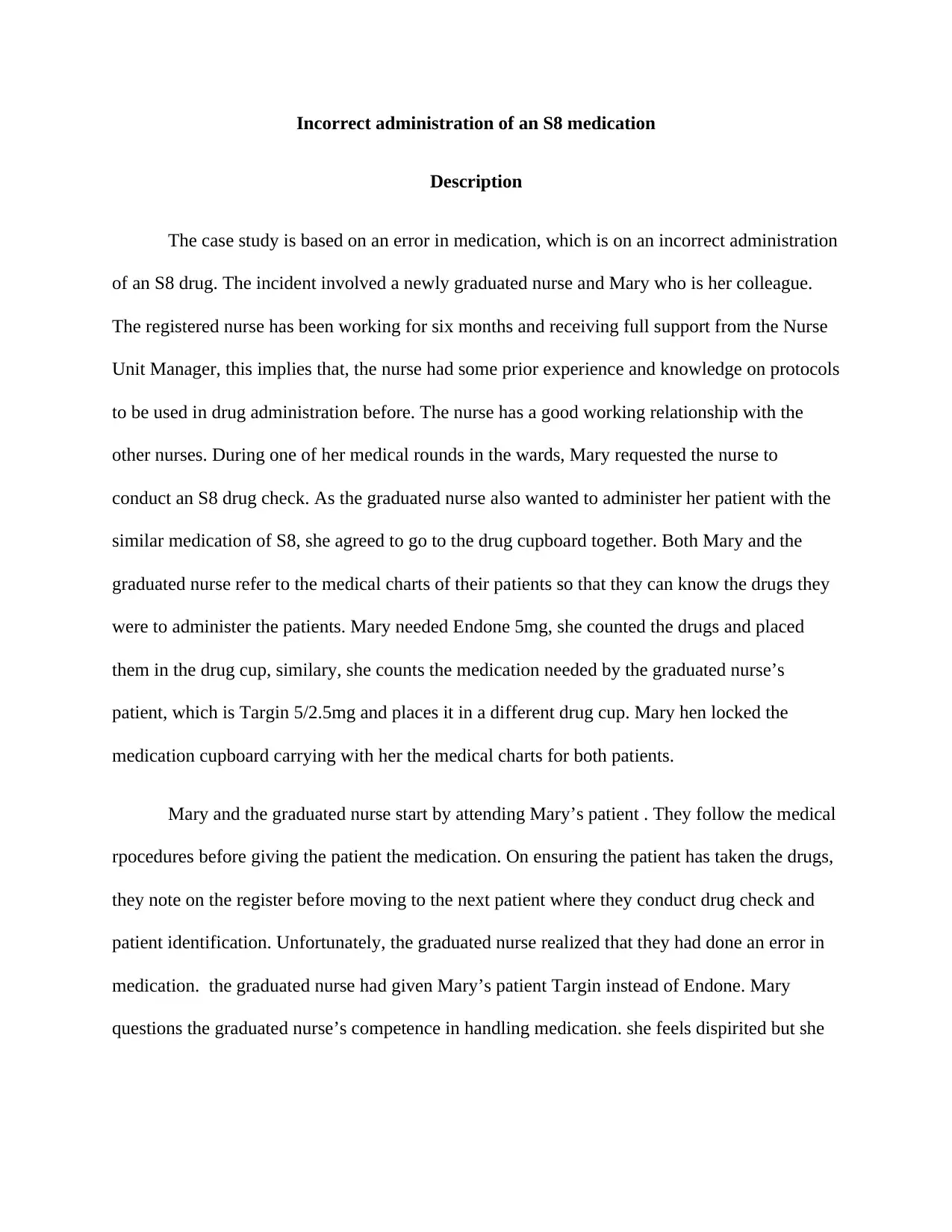
Incorrect administration of an S8 medication
Description
The case study is based on an error in medication, which is on an incorrect administration
of an S8 drug. The incident involved a newly graduated nurse and Mary who is her colleague.
The registered nurse has been working for six months and receiving full support from the Nurse
Unit Manager, this implies that, the nurse had some prior experience and knowledge on protocols
to be used in drug administration before. The nurse has a good working relationship with the
other nurses. During one of her medical rounds in the wards, Mary requested the nurse to
conduct an S8 drug check. As the graduated nurse also wanted to administer her patient with the
similar medication of S8, she agreed to go to the drug cupboard together. Both Mary and the
graduated nurse refer to the medical charts of their patients so that they can know the drugs they
were to administer the patients. Mary needed Endone 5mg, she counted the drugs and placed
them in the drug cup, similary, she counts the medication needed by the graduated nurse’s
patient, which is Targin 5/2.5mg and places it in a different drug cup. Mary hen locked the
medication cupboard carrying with her the medical charts for both patients.
Mary and the graduated nurse start by attending Mary’s patient . They follow the medical
rpocedures before giving the patient the medication. On ensuring the patient has taken the drugs,
they note on the register before moving to the next patient where they conduct drug check and
patient identification. Unfortunately, the graduated nurse realized that they had done an error in
medication. the graduated nurse had given Mary’s patient Targin instead of Endone. Mary
questions the graduated nurse’s competence in handling medication. she feels dispirited but she
Description
The case study is based on an error in medication, which is on an incorrect administration
of an S8 drug. The incident involved a newly graduated nurse and Mary who is her colleague.
The registered nurse has been working for six months and receiving full support from the Nurse
Unit Manager, this implies that, the nurse had some prior experience and knowledge on protocols
to be used in drug administration before. The nurse has a good working relationship with the
other nurses. During one of her medical rounds in the wards, Mary requested the nurse to
conduct an S8 drug check. As the graduated nurse also wanted to administer her patient with the
similar medication of S8, she agreed to go to the drug cupboard together. Both Mary and the
graduated nurse refer to the medical charts of their patients so that they can know the drugs they
were to administer the patients. Mary needed Endone 5mg, she counted the drugs and placed
them in the drug cup, similary, she counts the medication needed by the graduated nurse’s
patient, which is Targin 5/2.5mg and places it in a different drug cup. Mary hen locked the
medication cupboard carrying with her the medical charts for both patients.
Mary and the graduated nurse start by attending Mary’s patient . They follow the medical
rpocedures before giving the patient the medication. On ensuring the patient has taken the drugs,
they note on the register before moving to the next patient where they conduct drug check and
patient identification. Unfortunately, the graduated nurse realized that they had done an error in
medication. the graduated nurse had given Mary’s patient Targin instead of Endone. Mary
questions the graduated nurse’s competence in handling medication. she feels dispirited but she

has to report the incident to the Unit Nurse Manager so that an immediate action can be taken to
ensure the safety of the patient.
Factors leading to the Incident
The major factor leading to the incident is the failure to carry out the three drug check
properly. Despite the nurses conducting the drug check, they never did it effectively leading to
error in medication. The three drug check requires nurses to check the drugs three times before
giving them to the patients, this means that, the drug should be checked before and after
administering (Excellence, 2013). The aim is to ensure that the right drug and dosage is
administered to the right patient at the right time and through the right method (Westbrook,
Lehnbom, Baysari, Braithwaite, Burke & Day, 2015). The first check that the nurses should have
done was to take the drugs from the medical cupboard and compare it to what is given in the
patient’s medical record to check if they are agreeing. The second check would have been done
before giving it to the patient and the third check was to check the drug after administering it to
the patient (Kim & Bates, 2013). Mary and the graduate nurse conducted the first drug check
when retrieving it from the medical cupboard, which they compare to what is given in the
medical chart. However, the nurse fails o conduct the second drug check which is done right
before giving the patient the medication. In this case, the nurse does not identify the correct S8
medication for her patients as she does not take her time to check the drug label for the second
time before giving it to her patient. Error in medication can be detrimental, therefore, it is
imperative for healthcare providers to conduct the three drug check in order to avoid such
mistakes (McLeod, Barber & Franklin, 2013).
ensure the safety of the patient.
Factors leading to the Incident
The major factor leading to the incident is the failure to carry out the three drug check
properly. Despite the nurses conducting the drug check, they never did it effectively leading to
error in medication. The three drug check requires nurses to check the drugs three times before
giving them to the patients, this means that, the drug should be checked before and after
administering (Excellence, 2013). The aim is to ensure that the right drug and dosage is
administered to the right patient at the right time and through the right method (Westbrook,
Lehnbom, Baysari, Braithwaite, Burke & Day, 2015). The first check that the nurses should have
done was to take the drugs from the medical cupboard and compare it to what is given in the
patient’s medical record to check if they are agreeing. The second check would have been done
before giving it to the patient and the third check was to check the drug after administering it to
the patient (Kim & Bates, 2013). Mary and the graduate nurse conducted the first drug check
when retrieving it from the medical cupboard, which they compare to what is given in the
medical chart. However, the nurse fails o conduct the second drug check which is done right
before giving the patient the medication. In this case, the nurse does not identify the correct S8
medication for her patients as she does not take her time to check the drug label for the second
time before giving it to her patient. Error in medication can be detrimental, therefore, it is
imperative for healthcare providers to conduct the three drug check in order to avoid such
mistakes (McLeod, Barber & Franklin, 2013).
⊘ This is a preview!⊘
Do you want full access?
Subscribe today to unlock all pages.

Trusted by 1+ million students worldwide

The other factor that had contributed to the error is the failure by the nurses to execute
their duties autonomously. Each nurse was assigned their specific patient and each nurse was
supposed to administer the S8 medication to their assigned patient. In this case, after taking the
drugs from the cupboard, each nurse could have confirmed the drugs meant for their patient .
However, this was not done. Mary allowed the registered nurse to administer the drugs on her
behalf, which is a mistake. If she had administered the medication herself, she would have been
in a better position to identify the drugs before giving it to the patient. therefore, it is imperative
for nurses to execute their duties independently to avoid confusions and errors in medication
(Alsulami, Choonara & Conroy, 2014).
Finally, lack of pharmaceutical knowledge played a role in the incident. From the case
study analysis, the graduated nurse had been working in the wards for only six months, this
means that, she might have lacked the pharmaceutical experience and knowledge in drug
administration. Such knowledge is essential for healthcare providers to identify drugs. Therefore,
it is important for nurses to enhance their pharmaceutical knowledge to enable them differentiate
between medications (Ashcroft, Lewis,Tully, Farragher, Taylor, Wass & Dornan, 2015).
What I would have done differently
In my future practice as a nurse, I will make sure I follow the three drug check to avoid
mistakes. For instance, I had two medical cups, therefore, I would have been keen on the drug I
was administering to the patient. One of the best way I will do this is by being careful when
preparing the medication for my patients and by following drug administration procedures.
According to the NSQHS standards on the safety of medication states that healthcare providers
should follow the three drug check when giving patients medications to avoid mistakes
their duties autonomously. Each nurse was assigned their specific patient and each nurse was
supposed to administer the S8 medication to their assigned patient. In this case, after taking the
drugs from the cupboard, each nurse could have confirmed the drugs meant for their patient .
However, this was not done. Mary allowed the registered nurse to administer the drugs on her
behalf, which is a mistake. If she had administered the medication herself, she would have been
in a better position to identify the drugs before giving it to the patient. therefore, it is imperative
for nurses to execute their duties independently to avoid confusions and errors in medication
(Alsulami, Choonara & Conroy, 2014).
Finally, lack of pharmaceutical knowledge played a role in the incident. From the case
study analysis, the graduated nurse had been working in the wards for only six months, this
means that, she might have lacked the pharmaceutical experience and knowledge in drug
administration. Such knowledge is essential for healthcare providers to identify drugs. Therefore,
it is important for nurses to enhance their pharmaceutical knowledge to enable them differentiate
between medications (Ashcroft, Lewis,Tully, Farragher, Taylor, Wass & Dornan, 2015).
What I would have done differently
In my future practice as a nurse, I will make sure I follow the three drug check to avoid
mistakes. For instance, I had two medical cups, therefore, I would have been keen on the drug I
was administering to the patient. One of the best way I will do this is by being careful when
preparing the medication for my patients and by following drug administration procedures.
According to the NSQHS standards on the safety of medication states that healthcare providers
should follow the three drug check when giving patients medications to avoid mistakes
Paraphrase This Document
Need a fresh take? Get an instant paraphrase of this document with our AI Paraphraser

(Flanigan, 2016). In this case, to avoid such mistakes from happening, first, during the medical
checks, I will confirm more than ones to ensure the right patient receives the correct medication.
in addition, I will also ensure that I follow the proper procedures when administering drugs,
which include giving the right medication to the right patient, at a correct dose, and at the right
time. For instance, in the incidence, two patients were receiving medication which is almost
similar, I would have advised the nurses to label the drugs according to the drug names. By
doing so, it would have been easier for the graduated nurse to identify which medication
belonged to which patient.
In addition, at the bed side before giving the patient the medication, I could have used
patient identifiers to enable me identify the correct drug I was giving the patient. the most ideal
ways to identify the patient is by checking their identification number or name either verbally,
manually, or electronically to ensure the patients details are correct before giving them the
medicine. Also, drug confirmation is imperative as it reduces confusions, which can lead to
errors (Nanji, Patel, Shaikh, Seger & Bates, 2016). In this case, if I was in this kind of situation, I
would have confirmed the drugs before giving them to the patients. Alternatively, instead of me
giving the medication to both patients, I would have requested Mary to administer the
medication to her patient as I did to mine to avoid confusions. In addition, I would have
considered revising on my pharmaceutical knowledge in order to broaden my knowledge on
drugs and medication.
Finally, according to the NMBA codes of professional conduct and standards, it is
important for healthcare providers to follow protocol when administering medication (Australian
Nursing Council, 2003) . For instance, each nurse was assigned specific patients and no nurse
checks, I will confirm more than ones to ensure the right patient receives the correct medication.
in addition, I will also ensure that I follow the proper procedures when administering drugs,
which include giving the right medication to the right patient, at a correct dose, and at the right
time. For instance, in the incidence, two patients were receiving medication which is almost
similar, I would have advised the nurses to label the drugs according to the drug names. By
doing so, it would have been easier for the graduated nurse to identify which medication
belonged to which patient.
In addition, at the bed side before giving the patient the medication, I could have used
patient identifiers to enable me identify the correct drug I was giving the patient. the most ideal
ways to identify the patient is by checking their identification number or name either verbally,
manually, or electronically to ensure the patients details are correct before giving them the
medicine. Also, drug confirmation is imperative as it reduces confusions, which can lead to
errors (Nanji, Patel, Shaikh, Seger & Bates, 2016). In this case, if I was in this kind of situation, I
would have confirmed the drugs before giving them to the patients. Alternatively, instead of me
giving the medication to both patients, I would have requested Mary to administer the
medication to her patient as I did to mine to avoid confusions. In addition, I would have
considered revising on my pharmaceutical knowledge in order to broaden my knowledge on
drugs and medication.
Finally, according to the NMBA codes of professional conduct and standards, it is
important for healthcare providers to follow protocol when administering medication (Australian
Nursing Council, 2003) . For instance, each nurse was assigned specific patients and no nurse
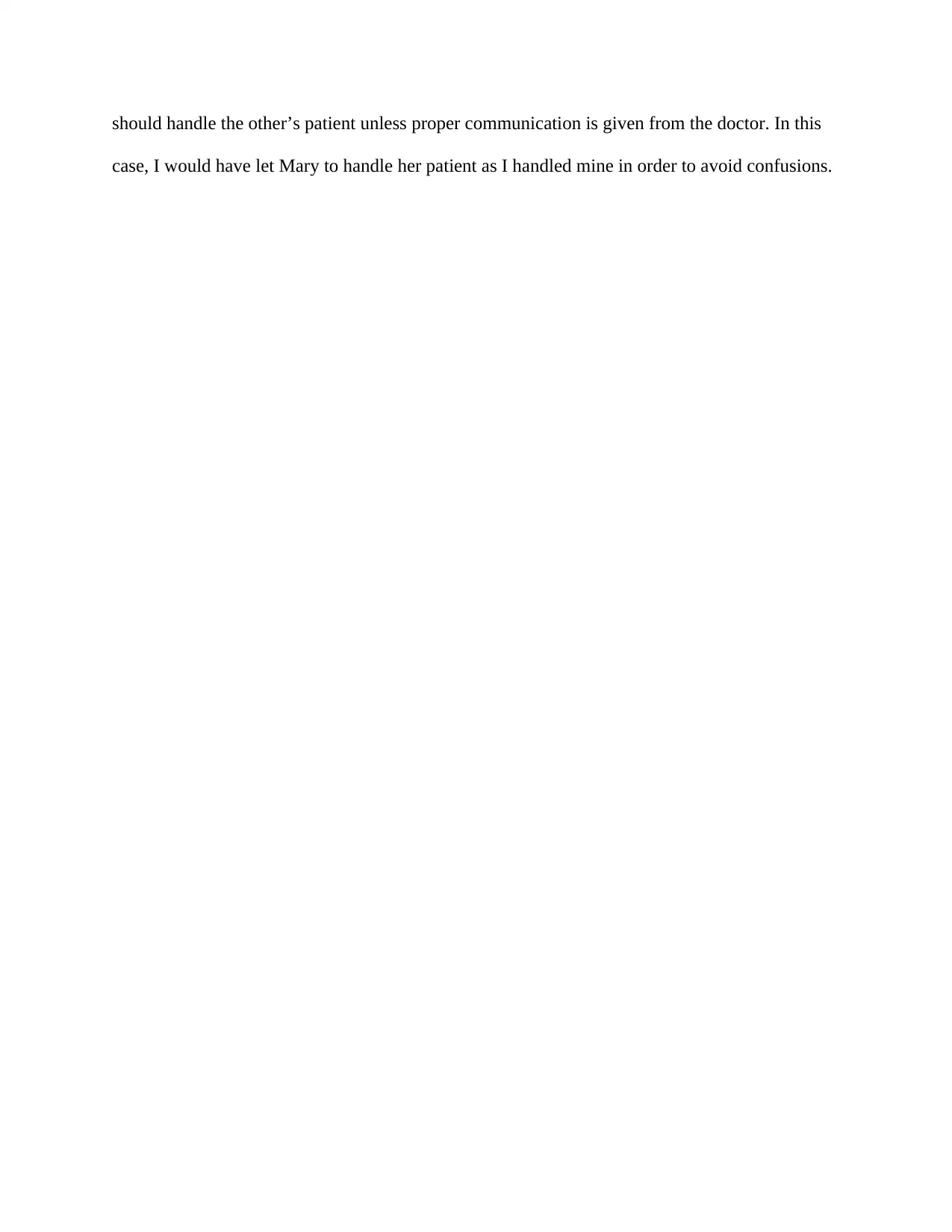
should handle the other’s patient unless proper communication is given from the doctor. In this
case, I would have let Mary to handle her patient as I handled mine in order to avoid confusions.
case, I would have let Mary to handle her patient as I handled mine in order to avoid confusions.
⊘ This is a preview!⊘
Do you want full access?
Subscribe today to unlock all pages.

Trusted by 1+ million students worldwide
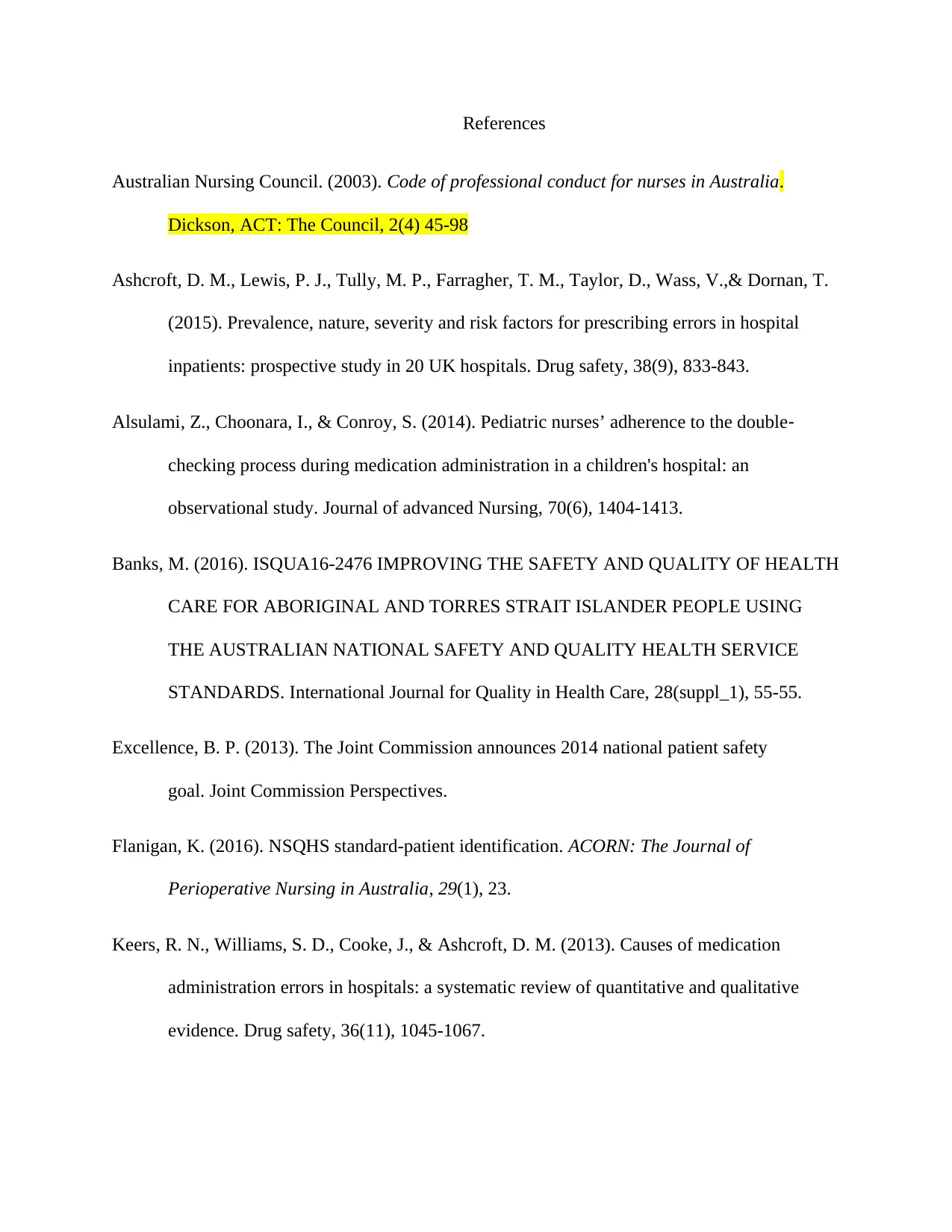
References
Australian Nursing Council. (2003). Code of professional conduct for nurses in Australia.
Dickson, ACT: The Council, 2(4) 45-98
Ashcroft, D. M., Lewis, P. J., Tully, M. P., Farragher, T. M., Taylor, D., Wass, V.,& Dornan, T.
(2015). Prevalence, nature, severity and risk factors for prescribing errors in hospital
inpatients: prospective study in 20 UK hospitals. Drug safety, 38(9), 833-843.
Alsulami, Z., Choonara, I., & Conroy, S. (2014). Pediatric nurses’ adherence to the double‐
checking process during medication administration in a children's hospital: an
observational study. Journal of advanced Nursing, 70(6), 1404-1413.
Banks, M. (2016). ISQUA16-2476 IMPROVING THE SAFETY AND QUALITY OF HEALTH
CARE FOR ABORIGINAL AND TORRES STRAIT ISLANDER PEOPLE USING
THE AUSTRALIAN NATIONAL SAFETY AND QUALITY HEALTH SERVICE
STANDARDS. International Journal for Quality in Health Care, 28(suppl_1), 55-55.
Excellence, B. P. (2013). The Joint Commission announces 2014 national patient safety
goal. Joint Commission Perspectives.
Flanigan, K. (2016). NSQHS standard-patient identification. ACORN: The Journal of
Perioperative Nursing in Australia, 29(1), 23.
Keers, R. N., Williams, S. D., Cooke, J., & Ashcroft, D. M. (2013). Causes of medication
administration errors in hospitals: a systematic review of quantitative and qualitative
evidence. Drug safety, 36(11), 1045-1067.
Australian Nursing Council. (2003). Code of professional conduct for nurses in Australia.
Dickson, ACT: The Council, 2(4) 45-98
Ashcroft, D. M., Lewis, P. J., Tully, M. P., Farragher, T. M., Taylor, D., Wass, V.,& Dornan, T.
(2015). Prevalence, nature, severity and risk factors for prescribing errors in hospital
inpatients: prospective study in 20 UK hospitals. Drug safety, 38(9), 833-843.
Alsulami, Z., Choonara, I., & Conroy, S. (2014). Pediatric nurses’ adherence to the double‐
checking process during medication administration in a children's hospital: an
observational study. Journal of advanced Nursing, 70(6), 1404-1413.
Banks, M. (2016). ISQUA16-2476 IMPROVING THE SAFETY AND QUALITY OF HEALTH
CARE FOR ABORIGINAL AND TORRES STRAIT ISLANDER PEOPLE USING
THE AUSTRALIAN NATIONAL SAFETY AND QUALITY HEALTH SERVICE
STANDARDS. International Journal for Quality in Health Care, 28(suppl_1), 55-55.
Excellence, B. P. (2013). The Joint Commission announces 2014 national patient safety
goal. Joint Commission Perspectives.
Flanigan, K. (2016). NSQHS standard-patient identification. ACORN: The Journal of
Perioperative Nursing in Australia, 29(1), 23.
Keers, R. N., Williams, S. D., Cooke, J., & Ashcroft, D. M. (2013). Causes of medication
administration errors in hospitals: a systematic review of quantitative and qualitative
evidence. Drug safety, 36(11), 1045-1067.
Paraphrase This Document
Need a fresh take? Get an instant paraphrase of this document with our AI Paraphraser
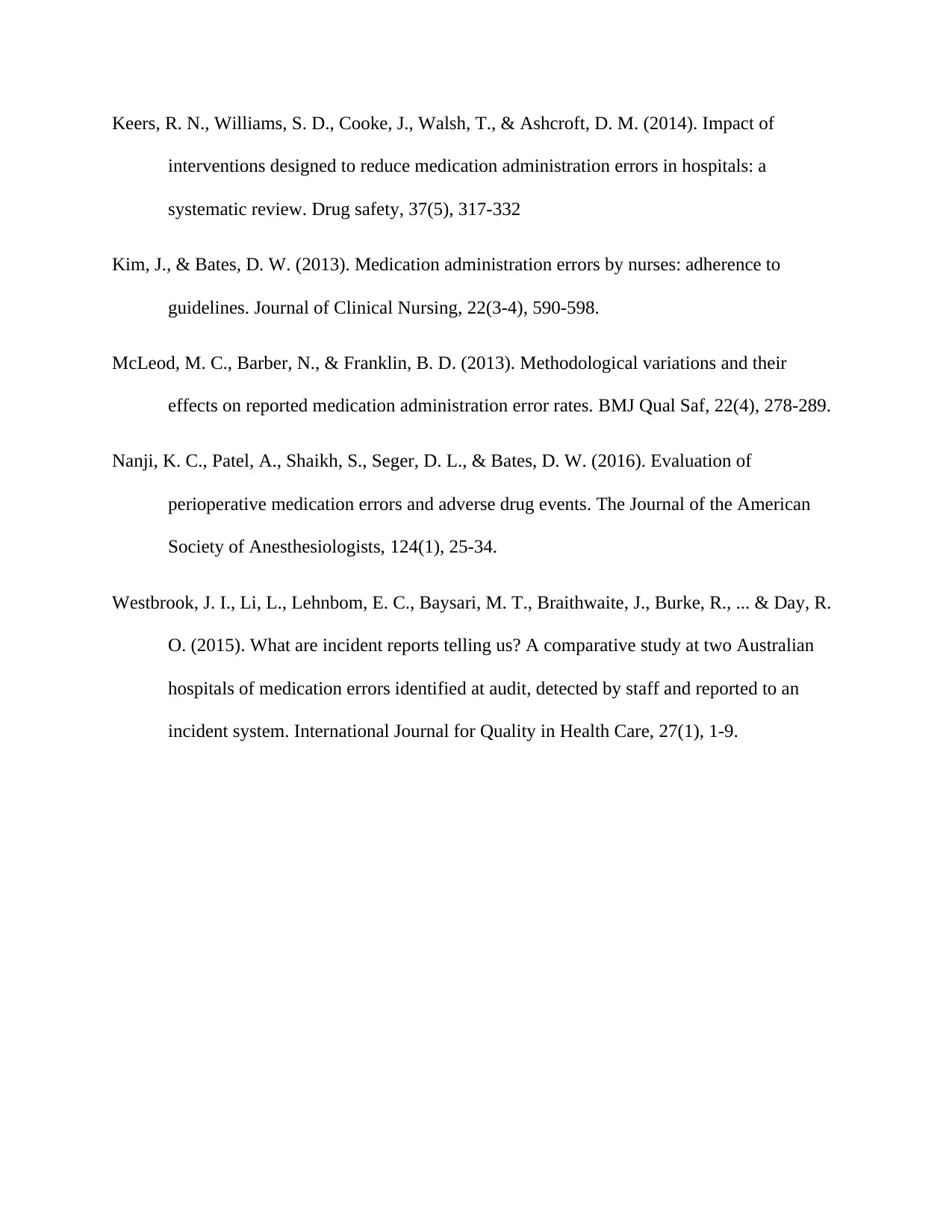
Keers, R. N., Williams, S. D., Cooke, J., Walsh, T., & Ashcroft, D. M. (2014). Impact of
interventions designed to reduce medication administration errors in hospitals: a
systematic review. Drug safety, 37(5), 317-332
Kim, J., & Bates, D. W. (2013). Medication administration errors by nurses: adherence to
guidelines. Journal of Clinical Nursing, 22(3-4), 590-598.
McLeod, M. C., Barber, N., & Franklin, B. D. (2013). Methodological variations and their
effects on reported medication administration error rates. BMJ Qual Saf, 22(4), 278-289.
Nanji, K. C., Patel, A., Shaikh, S., Seger, D. L., & Bates, D. W. (2016). Evaluation of
perioperative medication errors and adverse drug events. The Journal of the American
Society of Anesthesiologists, 124(1), 25-34.
Westbrook, J. I., Li, L., Lehnbom, E. C., Baysari, M. T., Braithwaite, J., Burke, R., ... & Day, R.
O. (2015). What are incident reports telling us? A comparative study at two Australian
hospitals of medication errors identified at audit, detected by staff and reported to an
incident system. International Journal for Quality in Health Care, 27(1), 1-9.
interventions designed to reduce medication administration errors in hospitals: a
systematic review. Drug safety, 37(5), 317-332
Kim, J., & Bates, D. W. (2013). Medication administration errors by nurses: adherence to
guidelines. Journal of Clinical Nursing, 22(3-4), 590-598.
McLeod, M. C., Barber, N., & Franklin, B. D. (2013). Methodological variations and their
effects on reported medication administration error rates. BMJ Qual Saf, 22(4), 278-289.
Nanji, K. C., Patel, A., Shaikh, S., Seger, D. L., & Bates, D. W. (2016). Evaluation of
perioperative medication errors and adverse drug events. The Journal of the American
Society of Anesthesiologists, 124(1), 25-34.
Westbrook, J. I., Li, L., Lehnbom, E. C., Baysari, M. T., Braithwaite, J., Burke, R., ... & Day, R.
O. (2015). What are incident reports telling us? A comparative study at two Australian
hospitals of medication errors identified at audit, detected by staff and reported to an
incident system. International Journal for Quality in Health Care, 27(1), 1-9.
1 out of 8
Related Documents
Your All-in-One AI-Powered Toolkit for Academic Success.
+13062052269
info@desklib.com
Available 24*7 on WhatsApp / Email
![[object Object]](/_next/static/media/star-bottom.7253800d.svg)
Unlock your academic potential
Copyright © 2020–2025 A2Z Services. All Rights Reserved. Developed and managed by ZUCOL.





